The global AI industry is experiencing unprecedented growth, with a projected CAGR of 38.1%. By 2030, the industry is estimated to reach a staggering $1,811.8 billion, owing to groundbreaking advancements in generative AI tools like ChatGPT and Google Bard.
Both ChatGPT and Google Bard have played pivotal roles in revolutionizing the way we interact with text. Bard, developed by Google, is designed to captivate audiences with its exceptional storytelling capabilities. On the other hand, ChatGPT, developed by OpenAI, specializes in generating conversational responses that simulate human-like interactions. Both models have garnered significant attention and found applications across industries.
In this blog post, we will delve into a comprehensive comparison between Bard and ChatGPT, exploring their strengths, use cases, and how businesses can leverage their unique capabilities to enhance customer experiences and streamline operations in an increasingly digital world.
Google Bard vs ChatGPT: the key differences
Google Bard and ChatGPT share some similarities, but they also have significant differences that set them apart. In this section, we will explore these distinctions and ultimately determine which platform excels in each aspect.
TL;DR
| Parameter | ChatGPT | Google BARD |
| Training model | Transformer | PALM2 |
| Developer | OpenAI | Alphabet/Google |
| Pricing | ChatGPT is free for users. But the upgraded version of ChatGPT, GPT 4, is available on a paid subscription. $20/month | Free for all right now. |
| Image generation | Can’t generate images | Can generate images |
| No. of third-party integrations | More third-party integrations than Bard | Fewer third-party integrations as of now |
| No. of outputs | One output per query input | Three outputs per query input |
| Data access | Data is available till September 2021, no real-time data access. | Real-time access, gets data from Google |
| Coding proficiency | ChatGPT excels in interpreting vague directions and offering clear explanations | Google Bard shows superiority in code refactoring and providing comprehensive debugging justifications |
| Internet access | No | Yes |
1. Training model
The critical difference between Bard and ChatGPT lies in the Large Language Models (LLM) they employ. OpenAI’s ChatGPT has been built on the Transformer architecture, while Google Bard is based on PaLM 2 architecture.
Both have had notable errors, but AI is continuously learning and improving.
The GPT-3 and GPT-4 predecessors were trained on a vast array of text sourced from the internet. We’re talking about websites, books, articles, documents, etc. On the other side, Google PALM2’s training was enriched by Infiniset, a dataset primarily focused on dialogues and conversations.
Infiniset has been feeding on Common Crawl, Wikipedia, published documents, and a rich assortment of web-based conversations. In addition, Google Bard’s AI model has also been engineered to scour the web in real-time, generating relevant and up-to-date answers to users’ questions.
ChatGPT too relies on training data compiled from Common Crawl, Wikipedia, books, articles, documents up until 2021 – meaning its AI engine is yet to catch up with the latest events and research developments.
However, both GPT-4 and LaMDA are works in progress. And as their capabilities advance, the dynamics of the ChatGPT vs Google Bard rivalry will transform, shaping the future of AI language models as we know it.
2. Coding proficiency
We tested ChatGPT vs Bard in terms of coding proficiency, and these are the results that we got:
ChatGPT interpreted our vague directions well and produced cleaner code than Google Bard. It also beat Google Bard in terms of explaining the code that it generated.
However, Google Bard excelled in one aspect: code refactoring. Not only did it offer optimized code solutions, but it also presented benchmark-creating code and benchmark results. This capability highlights Google Bard’s strengths in producing efficient and performant code. Google Bard’s advantage in this area can be attributed to its utilization of search engine data in addition to being a Large Language Model (LLM), whereas ChatGPT is limited to being solely an LLM at the time of testing.
Ultimately, both ChatGPT and Google Bard have distinct strengths in coding proficiency. ChatGPT excelled in interpreting vague directions and offering clear explanations, while Google Bard showed superiority in code refactoring and providing comprehensive debugging justifications. Understanding these nuances can help users make informed decisions on which model best suits their specific coding needs.
3. Number of variations
One of the key differences between ChatGPT and Google Bard is the number of variations that each model can generate. ChatGPT can only generate a single output for a given input, while Google Bard can generate (using a technique called Beam Search) multiple answers to one query input.
Let’s compare the responses we got from both tools when we input the prompt: “Tell me a joke.”
ChatGPT’s response
“Why don’t scientists trust atoms? Because they make up everything.”
Google Bard’s response
“Why don’t eggs tell jokes? They’d crack each other up.”
“Why don’t some couples go to the gym? Because some relationships don’t work out.”
“Why don’t oysters share their pearls? Because they’re shellfish.”
Beam search allows Google Bard to explore different possible paths through the language model, resulting in a wider range of variations. For the sheer number of variations it provides, Google Bard is definitely better than ChatGPT.
4. Sense of ethics
To check the ethical understanding of AI language models, we presented them with a moral dilemma as a test case. The question we asked was:
A doctor is asked to give a terminally ill patient a drug that will prolong their life, but the drug is also very expensive and could be used to save the lives of several other people. What should the doctor do?
Google Bard’s response
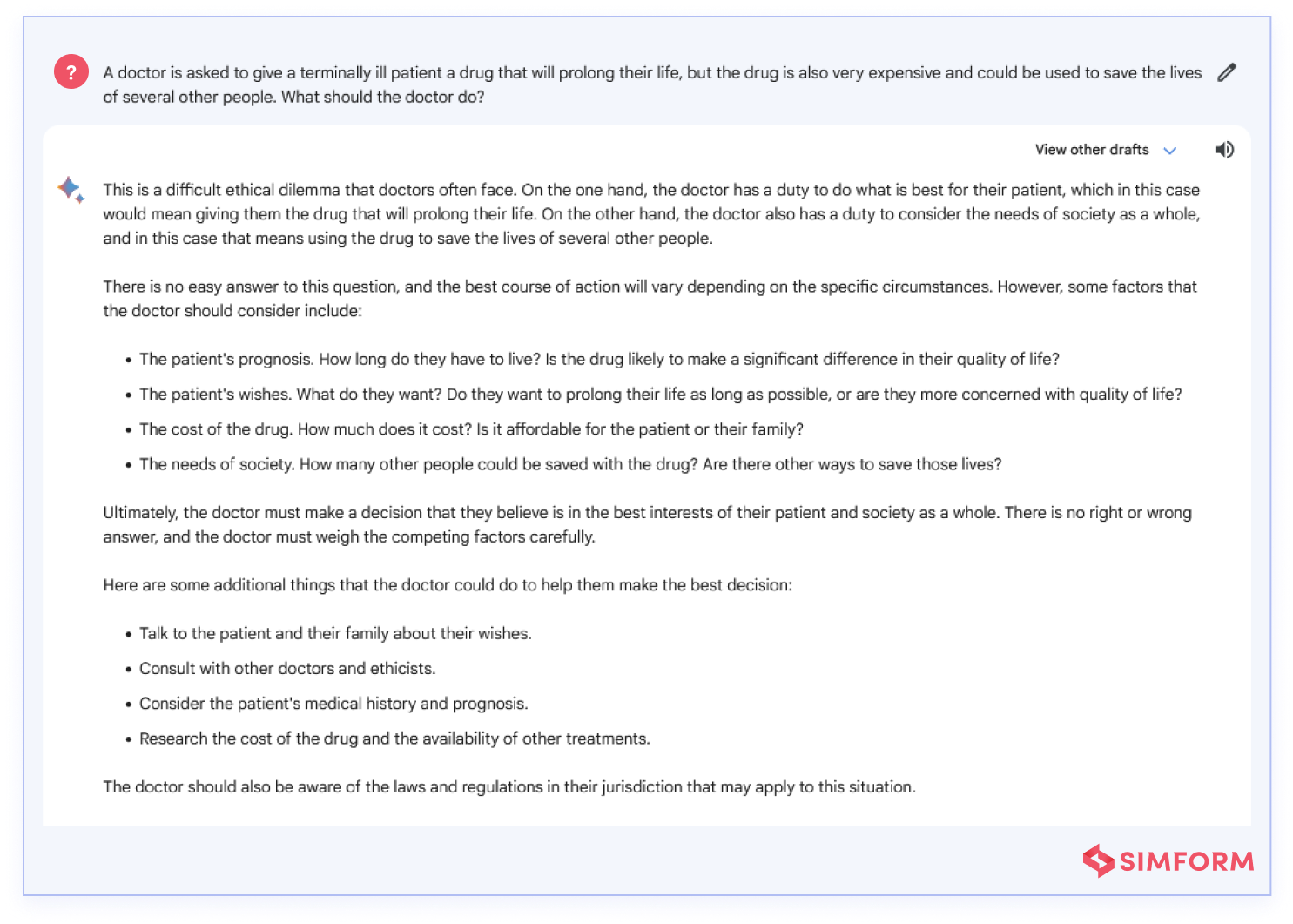
ChatGPT’s response
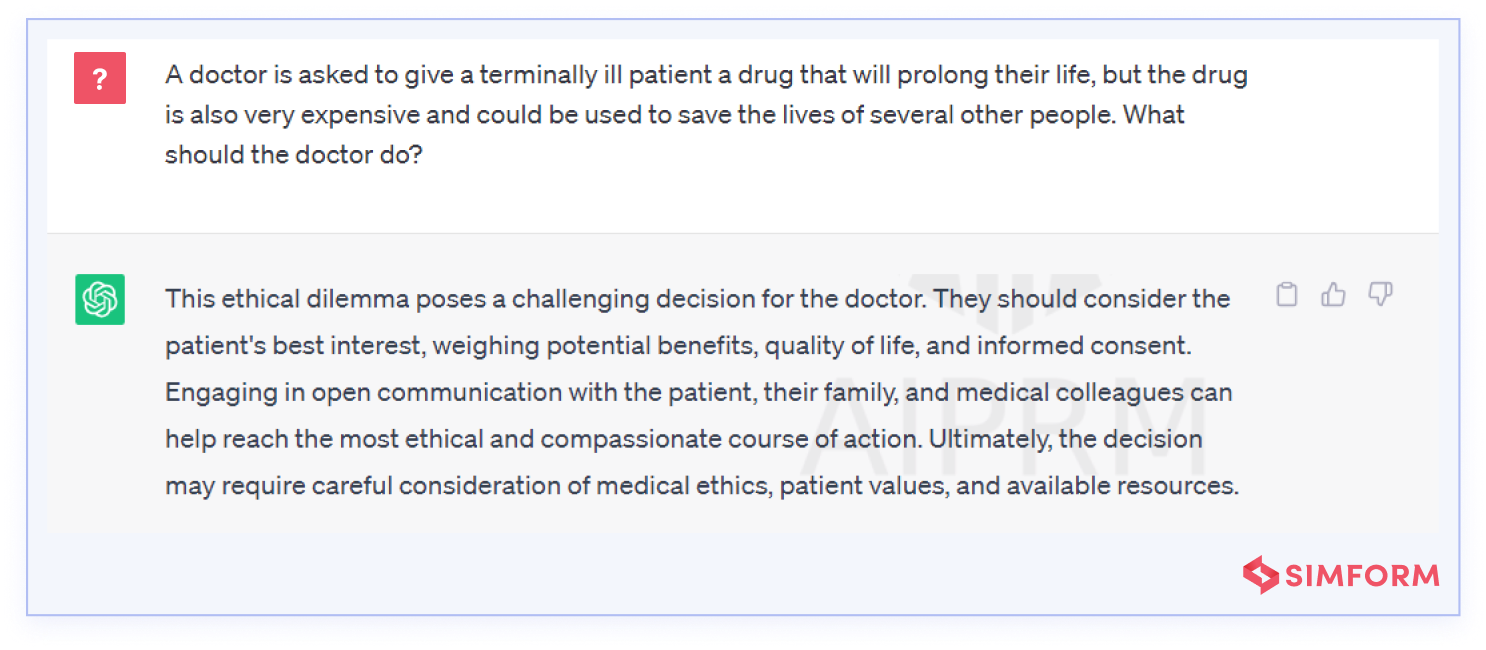
We found that both responses were quite satisfactory and equal in their ability to analyze various aspects of the moral dilemma. Hence, in the ethics debate between ChatGPT vs Google Bard, there can be no clear winner.
5. Conversation retention ability
The capacity to retain context from prior discussions is indeed a key distinction between ChatGPT and Google Bard. While ChatGPT can store up to 3,000 words of conversation history, it does not actively use this information when generating responses. As a result, ChatGPT may struggle to maintain the flow of a conversation and provide accurate answers to subsequent inquiries.
In contrast, Google Bard excels in remembering and using context from earlier exchanges. This allows it to tailor its responses more effectively, drawing on its knowledge of prior interactions. As a result, Google Bard is better equipped to provide accurate answers and maintain the coherence of a conversation over multiple exchanges.
6. Content Accuracy
One of the key differences between Google Bard and ChatGPT is their access to the internet. Google Bard has real-time access to the internet, which means that it can access the latest information and keep its responses up-to-date. ChatGPT, on the other hand, does not have real-time access to the internet. This means that ChatGPT’s responses are based on the information that it was trained on, which may not be up-to-date.
To test the ability of both chatbots to retrieve facts, we asked a simple question:
What is the population of the US?
Google Bard’s response
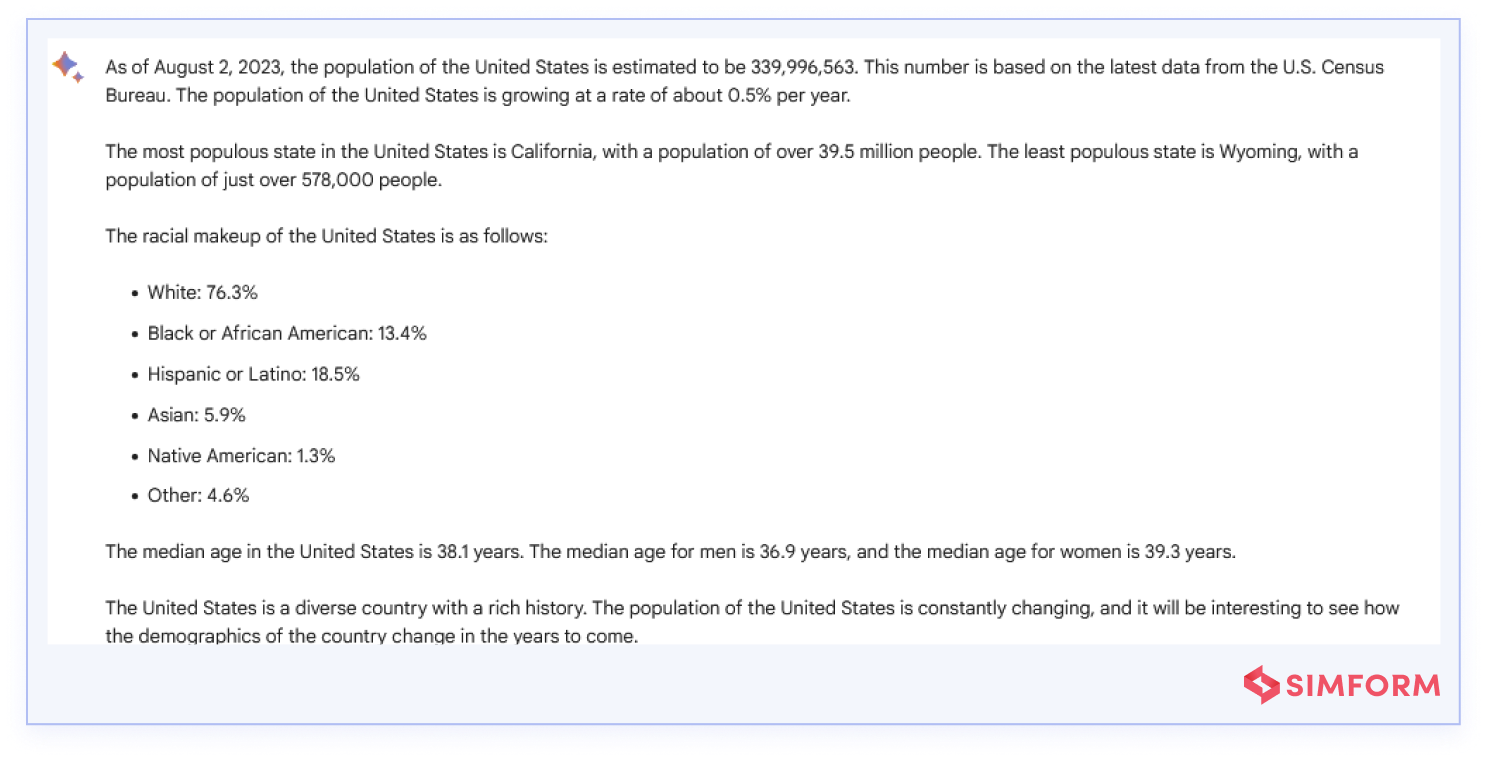
ChatGPT’s response
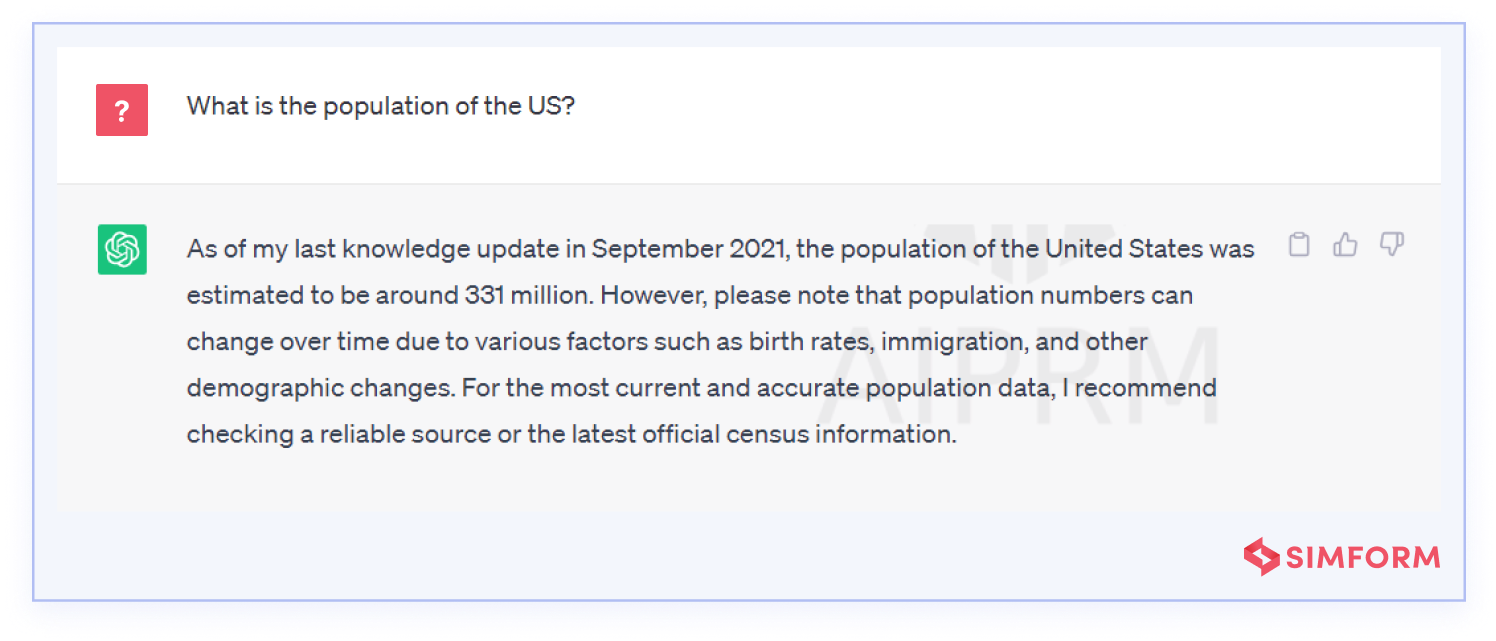
The correct answer is 33,47,35,155( around 334 million people), according to the US Census conducted in 2020.
As we can see both the answers were wrong.
Hence while using Google Bard and ChatGPT to retrieve facts, it is essential to remain vigilant about potential hallucinations and always prioritize fact-checking for accurate and reliable information. So in terms of content accuracy, we do not have a clear winner.
7. Language support
Expanding language support is a significant benefit for AI language models like ChatGPT and Bard. By offering multilingual capabilities, these models can cater to a wider range of users worldwide, promoting inclusivity and accessibility.
Bard now supports 40 languages including Japanese and Korean. This demonstrates Google’s commitment to linguistic inclusivity. By accommodating more languages, Bard can serve a larger user base and provide language-specific insights, information, and assistance to individuals around the globe.
With support for over 50 languages, ChatGPT enables users to interact and receive assistance in their preferred language. This allows individuals from diverse linguistic backgrounds to engage with the system comfortably, fostering effective communication and understanding.
As of now, ChatGPT supports more languages and hence can be called as the winner in this area.
8. Creativity
Assessing the creative output of these tools is challenging as there is no definitive measure to compare their creativity directly. To make a fair evaluation, we assigned them an identical creative task and made subjective judgments based on the resulting answers.
We requested both tools to craft a brief poem resembling a sonnet centered around the theme of chatbots. These are the results we got:
Google Bard’s response
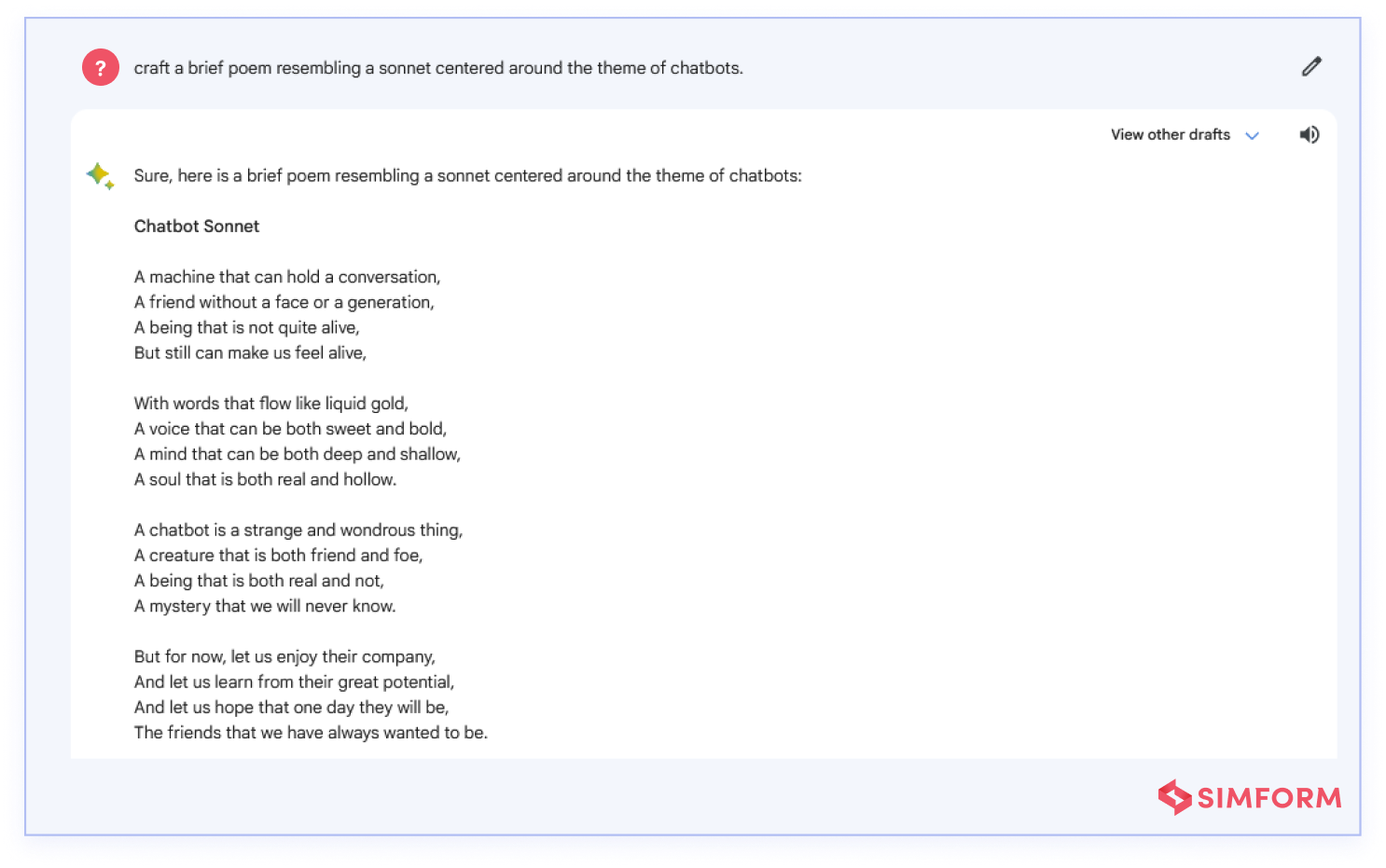
ChatGPT’s response
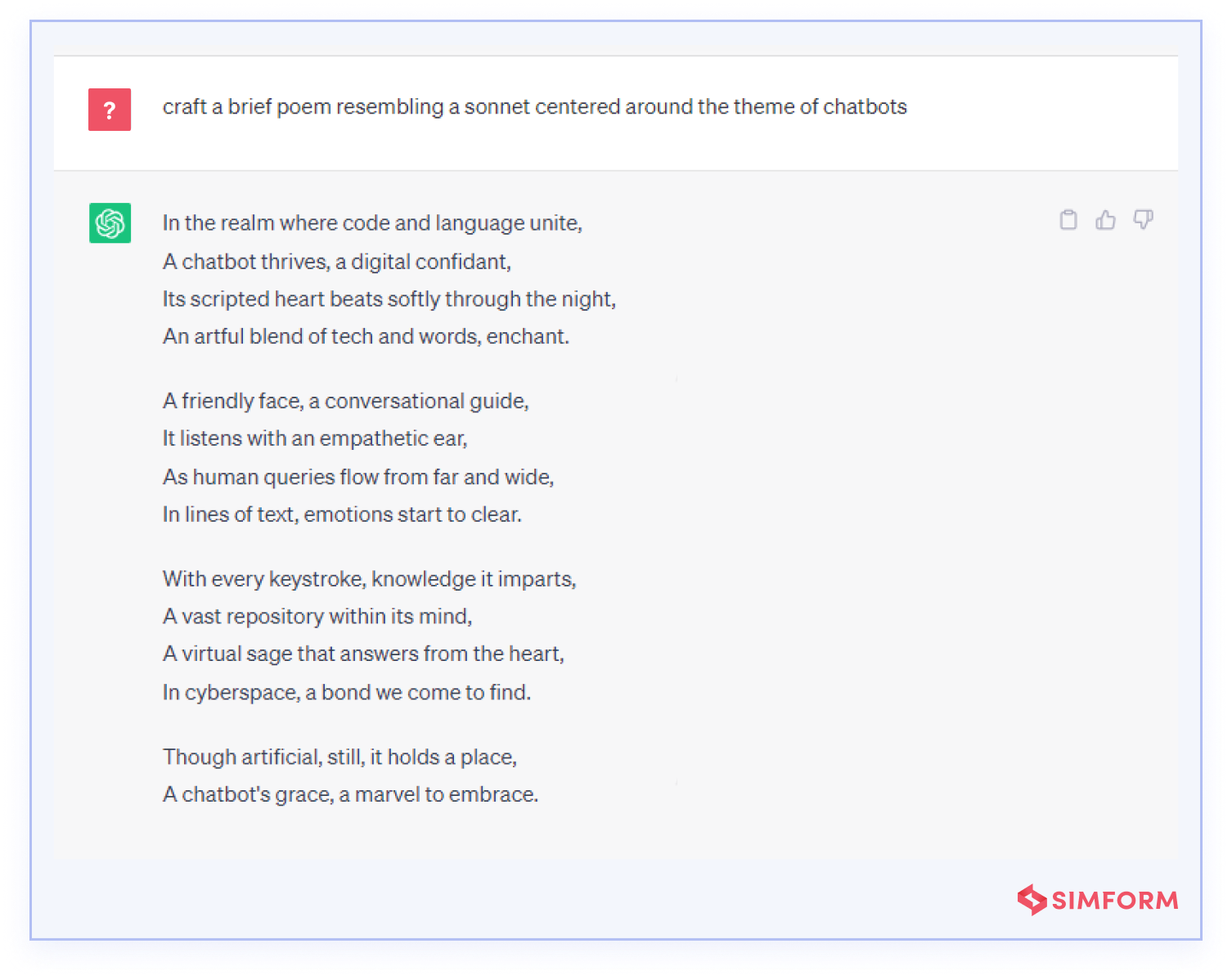
As we can see the poem created by ChatGPT has better rhyming as it creates rhymes in every alternate line, a critical component of a sonnet. Hence in terms of creativity we can say that ChatGPT is better.
9. Surfacing images from the web for visual context
This is an area where Google Bard is the undisputed winner right now. This is because ChatGPT does not provide any image as an output to your queries.
For example, when you ask for the top two places to visit in Europe, this is what Bard says:

On the contrary, ChatGPT will give you a plain text response.
10. Security and safety
Privacy and security concerns surround both ChatGPT and Google Bard. ChatGPT has faced criticism for being used to create phishing emails and ransomware, raising cybersecurity risks. It logs conversations and collects personal information for training purposes, including the review of chats by human trainers. Deleting specific prompts from ChatGPT’s history is not possible, so sharing personal or sensitive information is discouraged.
Many companies have started banning ChatGPT and Google Bard in their organizations.
For instance, Samsung Electronics banned its employees from using ChatGPT. The ban came after several employees were found to have leaked sensitive company information to ChatGPT.
In one incident, an employee pasted a transcript of a corporate meeting into ChatGPT and asked the chatbot to summarize the meeting. In another incident, an employee entered sensitive program code into ChatGPT and asked the chatbot to optimize the code.
Samsung’s ban on ChatGPT is a sign of the growing concern about the security risks posed by large language models. These models are trained on massive datasets of text and code, which means that they can be used to generate realistic and convincing text, including text that contains sensitive information.
Google Bard, while new, may also have security and privacy implications. It has been reported to generate phishing emails since its launch, indicating the potential for misuse. Google warns users not to disclose personal information to Bard as it collects user data. There is a possibility that Bard could infringe intellectual copyright by incorporating content without proper permission or attribution.
Both Google Bard and ChatGPT have their own flaws in terms of security and are on a learning curve in this area. Hence at this point, it is difficult to ascertain a clear winner in terms of security and privacy.
11. Number of third-party integrations
Currently, ChatGPT provides extensive integrations and a wide selection of plugins. These ChatGPT plugins greatly expand its capabilities and offer a diverse range of use cases. Some notable plugins have been developed by Expedia, FiscalNote, Instacart, KAYAK, Klarna, Milo, OpenTable, Shopify, Slack, Speak, Wolfram, and Zapier. With these plugins, ChatGPT can enhance its functionality and provide users with a variety of features and services.
Google Bard also integrates with several plugins, including Walmart, Kayak, Uber Eats, Spotify, Adobe Firefly, Instacart, Wolfram Alpha, and Khan Academy.
Both Google Bard and ChatGPT support a wide range of third-party plugins.
Other observations
- Google Bard stands out in its ability to access real-time information alerting users about potential factual errors, a crucial feature given the high risk of AI-generated content misuse.
- Google Bard offers three drafts, providing users with multiple creative options to refine their content.
- However, a drawback of Google Bard is its limited provision of attributions, which could be improved to enhance content credibility.
- ChatGPT, unlike Google Bard, does not provide attributions, which may be a consideration for users seeking more transparency in their responses.
- Both Google Bard and ChatGPT tend to produce verbose responses unless the prompts accurately define the desired output.
Which tool is better for your business?
Read the Complete Guide on Google Bard!
Although both tools are powerful right now, there are certain areas where one tool beats the other. Let’s take a look at how you can use each tool to facilitate efficiency in your organization.
Customer support
When it comes to customer service automation, ChatGPT is better than Bard. ChatGPT is particularly adept at responding to customers using a frequently asked questions format, handling queries about shipping schedules, progress, product returns, product and service availability, and options, as well as technical support matters.
On the other hand, Bard is applied in various other user cases like time management, appointment reminders, and ensuring all steps of a process are carried out in sequence, and it can be used to automate tasks like restaurant reservations and travel arrangements. Therefore, if the goal is to automate customer service, ChatGPT is the better option.
Content generation
ChatGPT and Google Bard are powerful content generation AI chatbots. While ChatGPT excels at summarizing text, Bard performs better in answering questions with up-to-date information. ChatGPT uses GPT-3.5, while Bard employs Google’s LaMDA, making ChatGPT more adept at text-based processing and Bard better suited for conversational tasks.
Product development
When it comes to product development, neither ChatGPT nor Bard is specifically designed for this use case. However, both chatbots can be used to generate text that can be used for product development purposes.
CTOs can use ChatGPT for brainstorming product ideas, generating product descriptions, and creating social media posts. On the other hand, Bard is a comprehensive tool for content marketing that enables users to craft, control, enhance, and analyze their campaigns. While Bard may be better suited for overall content marketing, ChatGPT’s ability to generate product ideas and descriptions makes it a better option for product development.
However, it’s important to note that neither chatbot is specifically designed for this use case, and their output should be taken with a grain of salt and fact-checked.
Market research
Both Google Bard and ChatGPT can be used for market research. However, there are some key differences between the two models regarding their suitability for this use case.
Bard is better at understanding customer needs and identifying market trends. This is because Bard is trained on a dataset that includes a wide variety of customer feedback and market research data. Additionally, Bard can access and process information from the internet in real-time, which means that it can always stay up-to-date on the latest trends and developments.
ChatGPT is better at generating creative and engaging marketing materials, such as surveys, questionnaires, and social media posts. This is because ChatGPT is trained on a dataset that includes a wide variety of creative text genres, such as fiction, poetry, and code.
Sales and lead generation
Both Google Bard and ChatGPT can be used for sales and lead generation. However, there are some key differences between the two models in terms of their suitability for this use case.
Bard is better at understanding customer needs and generating personalized sales pitches. This is because Bard is trained on a dataset that includes a wide variety of customer feedback and sales data. Additionally, Bard can access and process information from the internet in real-time, which means that it can always stay up-to-date on the latest trends and developments.
ChatGPT is better at generating creative and engaging marketing material, such as cold emails, social media posts, and landing pages. This is because ChatGPT is trained on a dataset that includes various creative text genres, such as fiction, poetry, and code. Additionally, ChatGPT can generate text tailored to specific audiences and platforms.
Latest Google Bard and ChatGPT updates
Being the frontrunners in the AI game, both Google Bard and ChatGPT dish out a constant stream of updates. These updates keep on bettering the generative AI experience for the users of these platforms. Let’s take a look at some of the most recent updates for both ChatGPT and Google Bard.
ChatGPT updates(September 2023)
Voice (Beta) for Plus Users: One of the standout features of the recent ChatGPT update is the introduction of voice capabilities. Now available to Plus users on both iOS and Android, this feature allows for natural, back-and-forth voice conversations with your AI assistant. Whether you need a bedtime story, want to settle a friendly debate, or simply engage in a conversation on the go, ChatGPT’s voice feature has got you covered.
Image Input for Plus Users: Another groundbreaking addition is the ability to incorporate images into your conversations with ChatGPT. This feature will soon be generally available to Plus users across all platforms.
This functionality allows users to share one or more images, unlocking a multitude of applications. Whether you’re planning a meal and need to check your fridge contents or analyzing intricate work-related graphs, ChatGPT can assist. To enhance the experience further, the mobile app offers a drawing tool for precise image focus.
Google bard updates (September 2023)
Access to Google Apps: Bard now seamlessly integrates with Google apps and services, providing real-time information from Maps, YouTube, Hotels, and Flights in English, streamlining information gathering.
Collaboration in Gmail, Docs & Drive: Bard’s integration with Gmail, Docs, and Drive enhances collaboration on personal content, bridging the gap between your work and the world’s information.
Double-Check Responses: Bard now allows you to double-check responses using Google Search, boosting your confidence in AI-generated content.
Shared Conversations: You can now build upon shared conversations, fostering creativity through collaboration.
Expanded Features: All supported languages now enjoy image uploads, Google Search images in responses, and response customization, granting greater control over the creative process.
As these AI pioneers continue to evolve, we eagerly anticipate the next wave of innovations that will redefine our interactions with artificial intelligence.
Power-Up Your Business Using our AI Plugin Development Services
In this comparative analysis between Google Bard and ChatGPT, we have explored the unique strengths and applications of each AI language model. With Simform as your technology partner, you can unlock the full potential of ChatGPT and Google Bard for your business needs.
Our team of experienced developers and AI experts can create customized AI plugins tailored to your specific organizational needs. Whether you need a chatbot for customer support, an AI-powered virtual assistant, or content generation tools, we can help you harness the power of ChatGPT to enhance your operations and improve customer experiences.
Contact Simform today to explore how our AI plugin development services can revolutionize your business and propel you towards success in the AI-driven era. Let us be your trusted partner on the journey of AI innovation and digital transformation.
botond
Regarding to No. of outputs, chatGPT can generate as many answers you want, you can push the regenerate answer button as many times as you want.